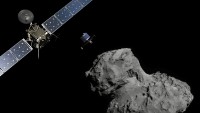Why ESA Is Extending Rosetta Mission By 9 Months
| KJ Belonio | | Jun 24, 2015 07:09 AM EDT |
(Photo : Getty Images/ESA) The Rosetta spacecraft of the European Space Agency (ESA) will continue its space exploration mission for 9 more months. According to the agency, Rosetta’s comet-chasing mission will be extended until September 2016.
Launched in 2004, the Rosetta spacecraft of the European Space Agency (ESA) will continue its space exploration mission for 9 more months. According to the agency, Rosetta's comet-chasing mission will be extended until September 2016.
Like Us on Facebook
On Tuesday, ESA's Science Programme Committee has given the Rosetta mission another nine months to study and explore Comet 67P/Churyumov-Gerasimenko, CBS News revealed. Though it was originally funded through the end of December, the adventure continues for the spacecraft, which may end with the dying mothership touching down on the comet and be finally reunited with its lander.
"ESA's Science Programme Committee has given formal approval to continue the mission for an additional nine months," ESA said.
The agency's Rosetta Project scientist, Matt Taylor, said that the extended space expedition mission is good news for science since they will be able to monitor the decline in the comet's activity as it moves away from the sun again.
"We'll have the opportunity to fly closer to the comet to continue collecting more unique data," Taylor stated. "By comparing detailed before and after data, we'll have a much better understanding of how comets evolve during their lifetimes."
ESA's daring Rosetta mission has been applauded as a momentous breakthrough in space exploration. It is an operation composed of an orbiter and a lander which seeks to unveil the deep secrets of comets that are primordial clusters of ice and dust that may give an insight on how life developed on Earth, ABC News has learned.
Following a 10-year chase, the Rosetta spacecraft and its Philae lander caught up with Comet 67P/Churyumov-Gerasimenko. In November 2014, Rosetta deployed its comet lander, Philae, to the surface of Comet 67P, making its first comet touchdown in space history. While it was able to send data back to Earth after almost 60 hours of establishing communication, its batteries ran out, forcing its systems to shut down, as previously reported.
Seven months after losing contact with Philae, ESA's comet lander has finally communicated back to planet Earth on June 13. The agency confirmed that the probe was able to send a signal back to Earth after its solar panels absorbed enough light from the sun. Philae has since continued establishing communication back home.
Meanwhile, scientists hope both Rosetta and Philae will have a grandstand view when Comet 67P reaches perihelion, which is its closest point to the Sun, on August 13. As per Hindustan Times, the comet will then orbit back into deep space and begin another six-and-a-half-year trek around our star.
If all goes as planned, scientific operations would continue, which would allow Rosetta's instruments to gather unique data at unprecedentedly close distances.
Tags Rosetta mission, ESA, european space agency, philae lander, outer space, Universe, comet 67P, Comet 67P/Churyumov-Gerasimenko
©2015 Chinatopix All rights reserved. Do not reproduce without permission
EDITOR'S PICKS
-

Did the Trump administration just announce plans for a trade war with ‘hostile’ China and Russia?
-

US Senate passes Taiwan travel bill slammed by China
-

As Yan Sihong’s family grieves, here are other Chinese students who went missing abroad. Some have never been found
-

Beijing blasts Western critics who ‘smear China’ with the term sharp power
-

China Envoy Seeks to Defuse Tensions With U.S. as a Trade War Brews
-

Singapore's Deputy PM Provides Bitcoin Vote of Confidence Amid China's Blanket Bans
-

China warns investors over risks in overseas virtual currency trading
-

Chinese government most trustworthy: survey
-

Kashima Antlers On Course For Back-To-Back Titles
MOST POPULAR
LATEST NEWS
Zhou Yongkang: China's Former Security Chief Sentenced to Life in Prison

China's former Chief of the Ministry of Public Security, Zhou Yongkang, has been given a life sentence after he was found guilty of abusing his office, bribery and deliberately ... Full Article
TRENDING STORY

China Pork Prices Expected to Stabilize As The Supplies Recover

Elephone P9000 Smartphone is now on Sale on Amazon India

There's a Big Chance Cliffhangers Won't Still Be Resolved When Grey's Anatomy Season 13 Returns

Supreme Court Ruled on Samsung vs Apple Dispute for Patent Infringement

Microsoft Surface Pro 5 Rumors and Release Date: What is the Latest?












